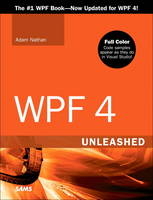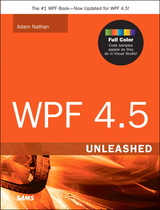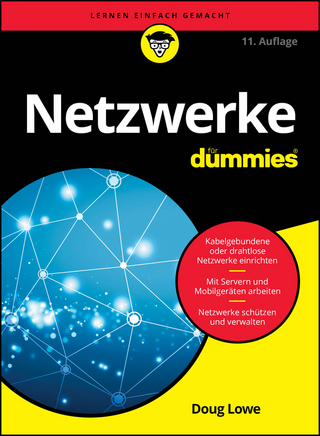
WPF 4 Unleashed
Sams Publishing (Verlag)
978-0-672-33119-0 (ISBN)
- Titel erscheint in neuer Auflage
- Artikel merken
Full Color: Code samples appear as they do in Visual Studio!
Thorough, authoritative coverage, practical examples, clear writing, and full-color presentation make this one of the most widely acclaimed programming books of the last decade.
Windows Presentation Foundation (WPF) is the recommended technology for creating Windows user interfaces, giving you the power to create richer and more compelling applications than you dreamed possible. Whether you want to develop traditional user interfaces or integrate 3D graphics, audio/video, animation, dynamic skinning, multi-touch, rich document support, speech recognition, or more, WPF enables you to do so in a seamless, resolution-independent manner. WPF 4 Unleashed is the authoritative book that covers it all, in a practical and approachable fashion, authored by WPF guru and Microsoft developer Adam Nathan.
Covers everything you need to know about Extensible Application Markup Language (XAML)
Examines the WPF feature areas in incredible depth: controls, layout, resources, data binding, styling, graphics, animation, and more
Highlights the latest features, such as multi-touch, text rendering improvements, XAML language enhancements, new controls, the Visual State Manager, easing functions, and much more
Delves into topics that aren’t covered by most books: 3D, speech, audio/video, documents, effects
Shows how to create popular UI elements, such as Galleries, ScreenTips, and more
Demonstrates how to create sophisticated UI mechanisms, such as Visual Studio-like collapsible/dockable panes
Explains how to create first-class custom controls for WPF
Demonstrates how to create hybrid WPF software that leverages Windows Forms, DirectX, ActiveX, or other non-WPF technologies
Explains how to exploit new Windows 7 features, such as Jump Lists and taskbar customizations
Adam Nathan is a principal software development engineer for Microsoft Visual Studio, the latest version of which has been transformed into a first-class WPF application. Adam was previously the founding developer and architect for Popfly, Microsoft’s first product built on Silverlight, named one of the 25 most innovative products of 2007 by PCWorld Magazine. Having started his career on Microsoft’s Common Language Runtime team, Adam has been at the core of .NET and WPF technologies since the very beginning. Adam’s books have been considered required reading by many inside Microsoft and throughout the industry. He is the author of the best-selling WPF Unleashed (Sams, 2006) that was nominated for a 2008 Jolt Award, Silverlight 1.0 Unleashed (Sams, 2008), and .NET and COM: The Complete Interoperability Guide (Sams, 2002); a coauthor of ASP.NET: Tips, Tutorials, and Code (Sams, 2001); and a contributor to books including .NET Framework Standard Library Annotated Reference, Volume 2 (Addison-Wesley, 2005) and Windows Developer Power Tools (O’Reilly, 2006). Adam is also the creator of PINVOKE.NET and its Visual Studio add-in. You can find him online at www.adamnathan.net, or @adamnathan on Twitter.
Introduction 1
Who Should Read This Book? 2
Software Requirements 3
Code Examples 4
How This Book Is Organized 4
Part I: Background 4
Part II: Building a WPF Application 4
Part III: Controls 5
Part IV: Features for Professional Developers 5
Part V: Rich Media 5
Part VI: Advanced Topics 6
Conventions Used in This Book 6
Part I Background
Chapter 1: Why WPF, and What About Silverlight? 9
A Look at the Past 10
Enter WPF 11
The Evolution of WPF 14
Enhancements in WPF 3.5 and WPF 3.5 SP1 15
Enhancements in WPF 4 16
What About Silverlight? 18
Summary 19
Chapter 2: XAML Demystified 21
XAML Defined 23
Elements and Attributes 24
Namespaces 26
Property Elements 29
Type Converters 30
Markup Extensions 32
Children of Object Elements . 35
The Content Property 35
Collection Items 36
More Type Conversion 38
Mixing XAML with Procedural Code 40
Loading and Parsing XAML at Runtime 40
Compiling XAML 43
Introducing XAML2009 48
Full Generics Support 49
Dictionary Keys of Any Type 50
Built-In System Data Types 50
Instantiating Objects with Non-Default Constructors 51
Getting Instances via Factory Methods 51
Event Handler Flexibility 52
Defining New Properties 53
Fun with XAML Readers and Writers 53
Overview 53
The Node Loop 56
Reading XAML 57
Writing to Live Objects 61
Writing to XML 63
XamlServices 64
XAML Keywords 67
Summary 70
Complaint 1: XML Is Too Verbose to Type 71
Complaint 2: XML-Based Systems Have Poor Performance 71
Chapter 3: WPF Fundamentals 73
A Tour of the Class Hierarchy 73
Logical and Visual Trees 75
Dependency Properties 80
A Dependency Property Implementation 81
Change Notification 83
Property Value Inheritance 85
Support for Multiple Providers 87
Attached Properties 89
Summary 93
Part II Building a WPF Application
Chapter 4: Sizing, Positioning, and Transforming Elements 97
Controlling Size 98
Height and Width 98
Margin and Padding 100
Visibility 102
Controlling Position 103
Alignment 103
Content Alignment 104
FlowDirection 105
Applying Transforms 106
RotateTransform 108
ScaleTransform. 109
SkewTransform. 112
TranslateTransform 112
MatrixTransform 112
Combining Transforms 113
Summary 114
Chapter 5: Layout with Panels 115
Canvas 116
StackPanel 118
WrapPanel 120
DockPanel 122
Grid 125
Sizing the Rows and Columns 130
Interactive Sizing with GridSplitter 132
Sharing Row and Column Sizes 134
Comparing Grid to Other Panels 136
Primitive Panels 137
TabPanel 137
ToolBarPanel 138
ToolBarOverflowPanel 138
ToolBarTray . 138
UniformGrid. 138
SelectiveScrollingGrid. 138
Handling Content Overflow 139
Clipping 139
Scrolling 141
Scaling 143
Putting It All Together: Creating a Visual Studio—Like Collapsible, Dockable, Resizable Pane 147
Summary 157
Chapter 6: Input Events: Keyboard, Mouse, Stylus, and Multi-Touch 159
Routed Events 159
A Routed Event Implementation 160
Routing Strategies and Event Handlers 161
Routed Events in Action 162
Attached Events 165
Keyboard Events 168
Mouse Events 170
MouseEventArgs 171
Drag and Drop 172
Capturing the Mouse 173
Stylus Events 174
StylusDevice 174
Events 175
Multi-Touch Events 176
Basic Touch Events 177
Manipulation Events for Panning, Rotating, and Zooming 180
Commands 188
Built-In Commands 189
Executing Commands with Input Gestures 192
Controls with Built-In Command Bindings 193
Summary 194
Chapter 7: Structuring and Deploying an Application 195
Standard Windows Applications 195
The Window Class 196
The Application Class 199
Showing a Splash Screen 205
Creating and Showing Dialogs 206
Persisting and Restoring Application State 209
Deployment: ClickOnce Versus Windows Installer 210
Navigation-Based Windows Applications 211
Pages and Their Navigation Containers 212
Navigating from Page to Page 214
Passing Data Between Pages 219
Gadget-Style Applications 223
XAML Browser Applications 224
Limited Feature Set 226
Integrated Navigation 228
Deployment 229
Loose XAML Pages 231
Summary 232
Chapter 8: Exploiting Windows 7 233
Jump Lists 233
JumpTask 234
JumpPath 241
Taskbar Item Customizations 245
Using a Taskbar Item Progress Bar 246
Adding an Overlay to the Taskbar Item 247
Customizing the Thumbnail Content 247
Adding Thumb Buttons to the Taskbar Thumbnail 248
Aero Glass 249
TaskDialog 253
Summary 256
Part III Controls
Chapter 9: Content Controls 261
Buttons 263
Button 264
RepeatButton 265
ToggleButton 265
CheckBox 266
RadioButton 266
Simple Containers 268
Label 268
ToolTip 269
Frame 271
Containers with Headers 272
GroupBox 273
Expander 273
Summary 274
Chapter 10: Items Controls 275
Common Functionality 276
DisplayMemberPath 277
ItemsPanel 278
Controlling Scrolling Behavior 280
Selectors 281
ComboBox 282
ListBox 287
ListView 290
TabControl 291
DataGrid 292
Menus 298
Menu 298
ContextMenu 301
Other Items Controls 302
TreeView 302
ToolBar 304
StatusBar 307
Summary 308
Chapter 11: Images, Text, and Other Controls 309
The Image Control 309
Text and Ink Controls 311
TextBlock 313
TextBox 315
RichTextBox 316
PasswordBox 316
InkCanvas 316
Documents 318
Creating Flow Documents 318
Displaying Flow Documents 329
Adding Annotations 331
Range Controls 334
ProgressBar 335
Slider 335
Calendar Controls 336
Calendar 336
DatePicker 338
Summary 339
Part IV Features for Professional Developers
Chapter 12: Resources 343
Binary Resources 343
Defining Binary Resources 344
Accessing Binary Resources 345
Localizing Binary Resources 350
Logical Resources 351
Resource Lookup 355
Static Versus Dynamic Resources 355
Interaction with System Resources 360
Summary 362
Chapter 13: Data Binding 363
Introducing the Binding Object 363
Using Binding in Procedural Code 363
Using Binding in XAML 365
Binding to Plain .NET Properties 367
Binding to an Entire Object 369
Binding to a Collection 370
Sharing the Source with DataContext 374
Controlling Rendering 375
String Formatting 375
Using Data Templates 378
Using Value Converters 381
Customizing the View of a Collection 386
Sorting 386
Grouping 388
Filtering 392
Navigating 392
Working with Additional Views 394
Data Providers 396
XmlDataProvider 397
ObjectDataProvider 401
Advanced Topics 403
Customizing the Data Flow 403
Adding Validation Rules to Binding 405
Working with Disjoint Sources 409
Putting It All Together: The Pure-XAML Twitter Client 412
Summary 414
Chapter 14: Styles, Templates, Skins, and Themes 415
Styles 416
Sharing Styles 418
Triggers 423
Templates 430
Introducing Control Templates 431
Getting Interactivity with Triggers 432
Restricting the Target Type 434
Respecting the Templated Parent’s Properties 435
Respecting Visual States with Triggers 442
Respecting Visual States with the Visual State Manager (VSM) 447
Mixing Templates with Styles 456
Skins 458
Themes 465
Using System Colors, Fonts, and Parameters 465
Per-Theme Styles and Templates 466
Summary 470
Part V Rich Media
Chapter 15: 2D Graphics 475
Drawings 476
Geometries 479
Pens 489
Clip Art Example 491
Visuals 493
Filling a DrawingVisual with Content 493
Displaying a Visual on the Screen 496
Visual Hit Testing 499
Shapes 505
Rectangle 507
Ellipse 508
Line 509
Polyline 510
Polygon 511
Path 511
Clip Art Based on Shapes 512
Brushes 513
Color Brushes 513
Tile Brushes 520
Brushes as Opacity Masks 527
Effects 529
Improving Rendering Performance 532
RenderTargetBitmap 532
BitmapCache 533
BitmapCacheBrush 535
Summary 535
Chapter 16: 3D Graphics 537
Getting Started with 3D Graphics 538
Cameras and Coordinate Systems 542
Position 543
LookDirection 544
UpDirection 548
OrthographicCamera Versus PerspectiveCamera 551
Transform3D 554
TranslateTransform3D 556
ScaleTransform3D 557
RotateTransform3D 559
Combining Transform3Ds 562
Model3D 563
Lights 563
GeometryModel3D 571
Model3DGroup 584
Visual3D 586
ModelVisual3D 587
UIElement3D 588
Viewport2DVisual3D 590
3D Hit Testing 592
Viewport3D 593
2D and 3D Coordinate System Transformation 596
Visual.TransformToAncestor 596
Visual3D.TransformToAncestor and Visual3D.TransformToDescendant 600
Summary 605
Chapter 17: Animation 607
Animations in Procedural Code 608
Performing Animation “By Hand” 608
Introducing the Animation Classes 609
Simple Animation Tweaks 616
Animations in XAML 621
EventTriggers Containing Storyboards 621
Using Storyboard as a Timeline 629
Keyframe Animations 630
Linear Keyframes 631
Spline Keyframes 633
Discrete Keyframes 634
Easing Keyframes 636
Easing Functions 637
Built-In Power Easing Functions 637
Other Built-In Easing Functions 639
Writing Your Own Easing Function 640
Animations and the Visual State Manager 643
Transitions 647
Summary 651
Chapter 18: Audio, Video, and Speech 653
Audio 653
SoundPlayer 654
SoundPlayerAction 654
MediaPlayer 655
MediaElement and MediaTimeline 656
Video 658
Controlling the Visual Aspects of MediaElement 658
Controlling the Underlying Media 661
Speech 664
Speech Synthesis 664
Speech Recognition 667
Summary 672
Part VI Advanced Topics
Chapter 19: Interoperability with Non-WPF Technologies 675
Embedding Win32 Controls in WPF Applications 677
A Win32 Webcam Control 678
Using the Webcam Control in WPF 681
Supporting Keyboard Navigation 687
Embedding WPF Controls in Win32 Applications 692
Introducing HwndSource 692
Getting the Right Layout 696
Embedding Windows Forms Controls in WPF Applications 699
Embedding a PropertyGrid with Procedural Code 700
Embedding a PropertyGrid with XAML 702
Embedding WPF Controls in Windows Forms Applications 704
Mixing DirectX Content with WPF Content 708
Embedding ActiveX Controls in WPF Applications 714
Summary 718
Chapter 20: User Controls and Custom Controls 721
Creating a User Control 723
Creating the User Interface of the User Control 723
Creating the Behavior of the User Control 725
Adding Dependency Properties to the User Control 728
Adding Routed Events to the User Control 731
Creating a Custom Control 732
Creating the Behavior of the Custom Control 733
Creating the User Interface of the Custom Control 739
Considerations for More Sophisticated Controls 743
Summary 750
Chapter 21: Layout with Custom Panels 751
Communication Between Parents and Children 752
The Measure Step 752
The Arrange Step 754
Creating a SimpleCanvas 755
Creating a SimpleStackPanel 760
Creating an OverlapPanel 763
Creating a FanCanvas 768
Summary 773
Index 775
| Verlagsort | Indianapolis |
|---|---|
| Sprache | englisch |
| Maße | 181 x 231 mm |
| Gewicht | 1554 g |
| Themenwelt | Mathematik / Informatik ► Informatik ► Netzwerke |
| Mathematik / Informatik ► Informatik ► Programmiersprachen / -werkzeuge | |
| Mathematik / Informatik ► Informatik ► Software Entwicklung | |
| Schlagworte | Windows Presentation Foundation 4; Handbuch/Lehrbuch |
| ISBN-10 | 0-672-33119-5 / 0672331195 |
| ISBN-13 | 978-0-672-33119-0 / 9780672331190 |
| Zustand | Neuware |
| Informationen gemäß Produktsicherheitsverordnung (GPSR) | |
| Haben Sie eine Frage zum Produkt? |
aus dem Bereich



